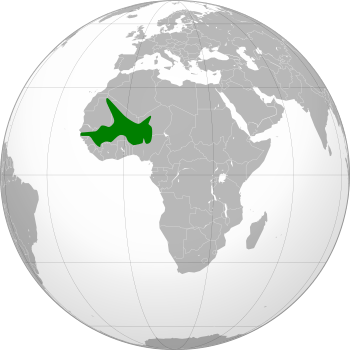Songhai Empire facts for kids
Quick facts for kids
Songhai Empire
|
|||||||||||||||
|---|---|---|---|---|---|---|---|---|---|---|---|---|---|---|---|
| c. 1464–1591 | |||||||||||||||

The territorial extent of the Songhai Empire in c. 1500.
|
|||||||||||||||
| Capital | Gao | ||||||||||||||
| Common languages | Songhai, Malinké, Mandinka, Fulani, Bozo, Soninke, Hausa, Mooré | ||||||||||||||
| Religion | Islam, African traditional religion | ||||||||||||||
| Government | Empire | ||||||||||||||
| Dia (King) | |||||||||||||||
|
• 1464–1492
|
Sunni Ali | ||||||||||||||
|
• 1492–1493
|
Sonni Bāru | ||||||||||||||
|
• 1493–1528
|
Askia the Great | ||||||||||||||
| Historical era | Postclassical Era | ||||||||||||||
|
• Songhai state emerges at Gao
|
c. 1000 | ||||||||||||||
|
• independence from Mali Empire
|
c. 1430 | ||||||||||||||
|
• Sunni Dynasty begins
|
1468 | ||||||||||||||
|
• Askiya Dynasty begins
|
1493 | ||||||||||||||
|
• Songhai Empire falls
|
1591 | ||||||||||||||
|
• Dendi Kingdom continues
|
1592 | ||||||||||||||
| Area | |||||||||||||||
| 1500 | 1,400,000 km2 (540,000 sq mi) | ||||||||||||||
| 1550 | 800,000 km2 (310,000 sq mi) | ||||||||||||||
| Currency | (Cowry shells, and gold coins) | ||||||||||||||
|
|||||||||||||||
The Songhai Empire (also transliterated as Songhay) was a state that dominated the western Sahel in the 15th and 16th century. At its peak, it was one of the largest states in African history. The state is known by its historiographical name, derived from its leading ethnic group and ruling elite, the Songhai. Sonni Ali established Gao as the capital of the empire, although a Songhai state had existed in and around Gao since the 11th century. Other important cities in the empire were Timbuktu and Djenné, conquered in 1468 and 1475 respectively, where urban-centered trade flourished. Initially, the empire was ruled by the Sonni dynasty (c. 1464–1493), but it was later replaced by the Askia dynasty (1493–1591).
During the second half of the 13th century, Gao and the surrounding region had grown into an important trading center and attracted the interest of the expanding Mali Empire. Mali conquered Gao towards the end of the 13th century. Gao would remain under Malian hegemony until the late 14th century. As the Mali Empire started to disintegrate, the Songhai reasserted control of Gao. Songhai rulers subsequently took advantage of the weakened Mali Empire to expand Songhai rule.
Under the rule of Sonni Ali, the Songhai surpassed the Malian Empire in area, wealth, and power, absorbing vast areas of the Mali Empire and reached its greatest extent. His son and successor, Sonni Bāru (1492–1493), was a less successful ruler of the empire, and as such was overthrown by Muhammad Ture (1493–1528; called Askia), one of his father's generals, who instituted political and economic reforms throughout the empire.
A series of plots and coups by Askia's successors forced the empire into a period of decline and instability. Askia's relatives attempted to govern the empire, but political chaos and several civil wars within the empire ensured the empire's continued decline, particularly during the brutal rule of Askia Ishaq I (1539–1549). The empire experienced a period of stability and a string of military successes during the reign of Askia Daoud (1549–1582/1583). Ahmad al-Mansur, the Moroccan sultan at the time, demanded tax revenues from the empire's salt mines.
Askia Daoud responded by sending a large quantity of gold as gift in an attempt to appease the sultan. Askia Ishaq II (1588–1591) ascended to power in a long dynastic struggle following the death of Askia Daoud. He would be the last ruler of the empire. In 1590, al-Mansur took advantage of the recent civil strife in the empire and sent an army under the command of Judar Pasha to conquer the Songhai and to gain control of the Trans-Saharan trade routes. After the disastrous defeat at the Battle of Tondibi (1591), the Songhai Empire collapsed. The Dendi Kingdom succeeded the empire as the continuation of Songhai culture and society.
Images for kids
-
The Timbuktu Manuscripts, with Arabic writings about mathematics and astronomy.
See also
 In Spanish: Imperio songhai para niños
In Spanish: Imperio songhai para niños




